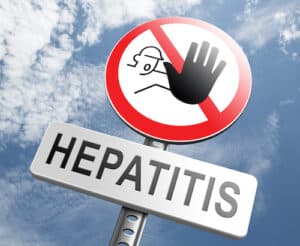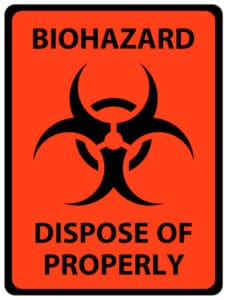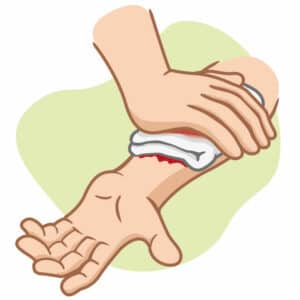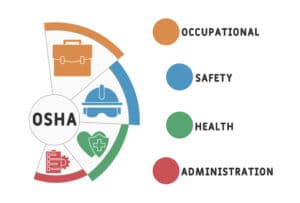Bloodborne Pathogens Toolbox Talk – [Updated for 2023]

Knowing about bloodborne pathogens, including the infectious microorganisms that create them, and how to stay safe when exposed to them isn’t just for first responders and healthcare workers. While healthcare workers may be one of the biggest at-risk groups, anyone can be exposed to bloodborne pathogens.
Employees who clean up materials exposed to bodily fluids, including human blood, and those who perform first aid are also at risk. This is why everyone should understand the essentials of this hazard and how to respond. All of your co-workers should also have a Bloodborne Pathogens Training Video you should check out as well. For now, let’s get started with this bloodborne pathogens toolbox talk.
What Are Bloodborne Pathogens?
A bloodborne pathogen is infectious and can cause disease. They are spread through the exchange of blood or other bodily fluids.
Three of the most common types are:
- Hepatitis B (HBV)
- Hepatitis C (HCV)
- Human immunodeficiency virus (HIV)
Some occupations require that employees come in contact with bloodborne pathogens, resulting in the need for guidelines and precautions that prevent exposure as much as possible. When exposure can’t be prevented, contact can be limited as much as possible to minimize the risk of harm to the health of employees.
Potentially Infectious Materials
Blood isn’t the only source of concern. Potentially infectious materials include bodily fluids such as:

- Saliva
- Semen
- Vaginal secretions
- Vomit
- Synovial fluid
- Pericardial fluid
- Pleural fluid
Workers can be more likely to be in contact with these fluids as well, depending on their job code or classification. Bloodborne pathogens and other potentially infectious materials can be transmitted when they come in contact with an individual’s mucous membranes. In other words, the eyes, nose, mouth, or even broken skin from a cut, burn, or sore. Any of these areas are vulnerable to infection or the spread of disease if they work closely with or touch contaminated materials or surfaces. Understanding how bloodborne pathogens are transmitted is an important piece of any employee training program.
Human Immunodeficiency Virus (HIV)
HIV is a lifelong virus that attacks the body’s immune system. If it’s not treated on time, it can turn into acquired immunodeficiency syndrome (AIDS). Although there is no cure for the virus, proper medical care allows it to be controlled. Effective HIV treatment allows individuals to live long, healthy lives.
HIV can be transmitted through the exchange of bodily fluids (not including saliva), sharing needle sticks or syringes, and other drug injection equipment. However, by following safety precautions, individuals are able to keep themselves and each other safe in a variety of situations.
How Can Individuals Be Exposed to Bloodborne Pathogens and Other Potentially Infectious Materials?
Minimizing employee exposure is the main goal when it comes to working with the threat of hazards. There are many occupations where employees can be exposed to bloodborne pathogens and other potentially infectious materials in a number of ways. Although there are many different occupations that require bloodborne pathogens training, here are some of the examples:
- First responders
- Doctors and nurses
- Housekeeping personnel
Individuals can be exposed to any of these hazards through handling or coming in direct contact with contaminated materials or surfaces. One common way that bloodborne pathogens are transmitted is through being injected with a sharp object, oftentimes a needle. Luckily, there are universal precautions that can prevent employees from being injured and risking their health when they handle these types of materials.
BBP Toolbox Talk – Universal Precautions to Follow
In order to keep workers safe, a written exposure control plan must be written and implemented as part of the workplace safety program. This plan is essential for any employees who could be in danger of bloodborne pathogens for any reason.
To ensure that all employees are aware of their occupational exposure risk and understand what to do when exposed, each employee must complete the mandatory exposure control training before their first day of work at the facility or in the role of a new duty.
Universal precautions means that all blood and potentially infectious bodily fluids are treated as if they are known to be infected with bloodborne pathogens. This prevents the possibility of contracting any diseases or infections once individuals have been exposed to blood or any body fluids.
Bloodborne pathogens can also be transmitted by ingestion and through blood or other bodily fluids. In a workplace setting, transmission often takes place from an infected person through used needle sticks, biting, cuts, or through proximity to the eyes or nose.

There are two main types of BBP exposure: direct and indirect:
Direct exposure: Direct exposure to bloodborne pathogens is when infected blood or any body fluid from one person is transmitted to the body of another person. Examples include infected blood splashing into your eye or an open wound on your skin.
Indirect exposure: Indirect exposure to bloodborne pathogens is when infected blood or body fluids are transmitted from one person to another via an object or surface. Examples include a used needle pricking the finger of another person who wasn’t wearing gloves or using ungloved hands to handle discarded bandages despite having an open cut on their hands, which serves as an entry point for an infection.
Only employees who are trained and dedicated to using personal protective equipment (PPE) and engineering controls should perform cleanup procedures. This is important for situations that involve blood spills or the need for any possibly infectious materials to be cleaned up from the floor and any other surfaces or materials that employees handle or will touch those they handle. For instance, employees should put on disposable gloves before handling any bodily fluids.
OSHA Regulations
The Occupational Safety and Health Administration (OSHA) has a bloodborne pathogen regulation that traditionally applies to workers in healthcare. However, the regulations can extend to employees that work in other industries who face potential exposure to bloodborne pathogens. This includes individuals who administer first aid, work in housekeeping, or are janitorial staff. These precautions are instated to protect all individuals in the workplace.
These regulations are mandatory for all employers and their employees to follow. In order for facilities to be OSHA compliant, employers are required to implement an exposure control plan that includes thorough details on employee protection measures for different types of facility hazards. The plan must also contain how an employer will handle other factors, including:
- Engineering controls
- Work practice controls
- Personal protective equipment (PPE)
- Employee training
- Required hepatitis B vaccinations, and
- All other standard OSHA provisions.
In the event that you are directly exposed to hazardous materials without the proper protective equipment, it’s essential that you immediately flush or scrub the exposed area with warm water and soap. You should then notify a supervisor and consider whether the next course of action is to seek medical attention.
How to Prevent Infection
There are several important ways to prevent infection by becoming exposed to a BBP. Here are some examples:
- Avoid directly and indirectly touching the fluids of others.
- Always wear disposable gloves when administering first aid.
- Use these forms of PPE: eye protection, shoe coverings, gowns, and breathing guards if they are required by your workplace for their safety control plan or if the particular situation calls for wearing additional protecting layers.
- Dispose of sharps into their designated containers. Sharps are typically used for needles, but they can also include contaminated glass, razors, or knives.
- Always avoid touching your eyes, nose, and mouth during or after administering first aid.
- Whenever you remove disposable gloves, do so without allowing the soiled part of the gloves to touch you. First, safely dispose of the soiled one, then dispose of the next one in the proper receptacle.
- Always thoroughly wash your hands with soap and warm water, as well as all other affected areas, immediately after providing care or handling hazardous materials.
Take note that you should always take the time to decontaminate surfaces once they have been used or soiled. This includes PPE, equipment, working surfaces, and the floor. Don’t ever skip this step. Bloodborne pathogens remain infectious for days outside of the body. This is why hazardous materials including syringes and bandages should not be handled without the proper protection.
What to Do If You’re Possibly Exposed
- If you think you may have touched any bloodborne pathogens directly or indirectly, don’t panic. Instead, take the following actions.
- Wash any injuries and areas or open cuts thoroughly with soap and water. You should also flush the nose and mouth.
- If any fluids are splashed in or around the eyes, flush them with water or saline for up to 30 minutes.
- Report the situation to a supervisor or any appointed person within the company. Then make a record of what happened and file an incident report.
- Immediately seek medical care even if it doesn’t appear to be a big deal at the moment. Infections can take time to appear to have adverse health effects.
- Continue to follow any additional steps that your employer has outlined in the safety plan.
If hazards such as the ones discussed are common in your workplace, don’t skip any of these steps. You also don’t want to skip the safety meeting where you will be given all of the essential safety information. You never know when an accident might happen.

Bloodborne Pathogens Summary
Refer to this bloodborne pathogens toolbox talk that includes information on what they are, who is in danger of them, and safety precautions that can be taken to avoid contracting or spreading disease in the workplace. This information is supplemented by regulations from the Occupational Safety and Health Administration (OSHA) to keep employees everywhere safe.
While you may not work in an industry where bloodborne pathogen exposure is commonplace, you should still be aware of how to prevent and react to being close to any such hazards. Following OSHA and workplace guidelines can help keep you safe and maybe even save your life.